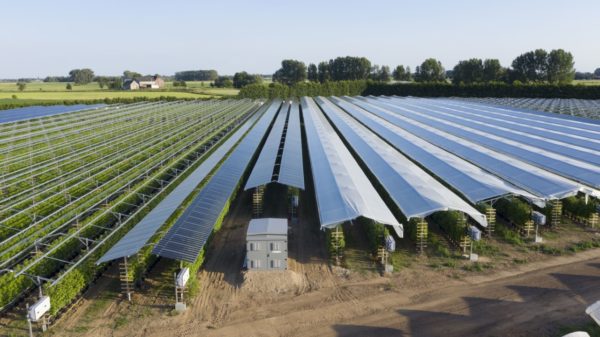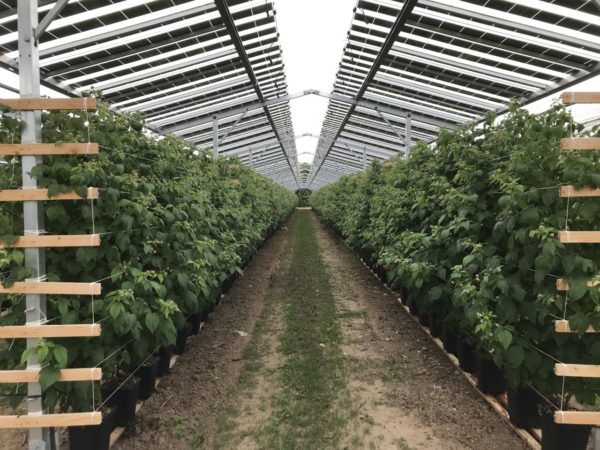BayWa r.e. and its Dutch subsidiary, GroenLeven, are building five pilot agrivoltaic power projects in the Netherlands, where they are testing five different types of crops: blueberries, red currants, raspberries, strawberries, and blackberries.

Image: GroenLeven
The largest of the projects – a 2.67 MW solar plant deployed on a 3.2-hectare surface devoted to raspberry cultivation – is located in the Dutch municipality of Zevenaar, near the city of Arnhem at the Dutch-German border.
The two companies are not relying on standard PV modules for the project, as such products are considered unsuitable in an efficient agrivoltaic project. “We have used special monocrystalline solar panels that were produced to our specifications,” Willem De Vries, project manager for AgriPV at GroenLeven, told pv magazine.
De Vries said the special requirements are related to transparency, as plants below the panels need to receive sufficient light, while being protected by a foil cover from direct sunlight, rain, hail and frost. De Vries said that the sunlight hitting the raspberries should not be too strong.
“So far, we built two different pilot projects, with two kinds of panels with different levels of transparency,” he explained. “With increased panel transparency, the crop yield grows significantly.”
GroenLeven used 260 W glass-glass panels which weigh more than their ‘normal’ counterparts, at approximately 35 kg per panel. “We applied relatively thick glass layers, to feel more secure that the panels would hold off any weather type,” De Vries added, without disclosing more technical details.
Passive cooling is applied to the crops in two different ways. First, the panels absorb some of the incoming radiation. Second, the modules are set up in such a way that the air can pass through them. The natural airflow ensures that the atmosphere under the plants is cooler than ambient conditions, and much cooler than standard foil coverings.
Heat dissipation
Raspberries are grown with support systems made of wood, concrete and metal. GroenLeven and BayWa r.e. decided to replace such structures with new designs and special panels. “The mounting systems were also designed specifically for this project and it is the first time that it has been applied,” De Vries added.

Image: GroenLeven
GroenLeven said the supporting structures were designed so heat is quickly transported away in a passive manner. “We learned that the exact percentage of light is very important, but we also learned that the climate under the solar panels is structurally better than under the conventional plastic covering,” he said. “We can see this now in our monitoring. On hot days, the temperature under the panels is 5 degrees lower than under the plastic coverings, and even 2 degrees lower than in ambient circumstances.”
This heat dissipation is beneficial for the plants. At night, the temperature under the panels is higher, as they retain the warmth better than the plastic coverings. This effect is considered beneficial for the plants. “The humidity is also more stable under the panels as compared to standard coverings,” De Vries said.
The new support structures are also beneficial to farmers, as they are said to be less vulnerable to strong winds, hence, less or no labor is needed compared to conventional foil-based growing systems. “Our setup does not rupture due to winds, nor does it fly away or move off the structure,” De Vries said. “This all happens to plastic covering. If strong winds occur the plastic slides off, ruptures or simply flies away. Our installation saves the farmer some worrisome nights.”
The two companies are currently designing the structures in partnership with unnamed “trusted suppliers.”
Cost considerations
Although the two companies have yet to provide specifics on project costs and the levelized cost of energy, De Vries said that farmers will benefit financially. They can save on support structures, which are already integrated into the solar mounting systems.

Image: GroenLeven
“At this stage the costs of AgriPV installations are of course significantly higher than for ground-mounted installations,” De Vries said. “But those will drop due to experience, optimizations and a supply chain that gets used to our special requests.”
The two companies expect the understructure and the panels to drop in price once the suppliers have received enough orders. “And our internal costs will also improve further due to experience,” Stephan Schindele, head of AgriPV at BayWa r.e.,” told pv magazine.
Crop quality
The pilot agrivoltaic projects are improving crop yield, but also quality, according to the developers. Farmers might be willing to accept lower yields if quality and pricing is higher, or if overall production quality increases at lower costs.
Raspberries are capable of handling shade. “This year we have also started pilots with several other berries and we strongly believe that all crops will have their own requirements and will react differently to the circumstances created by agrivoltaics,” Schindele said. “It is therefore important to obtain experience with many crops.”
New mindset
According to Schindele and De Vries, project development in this segment requires skilled designers. “Solar radiation engineers are required for this kind of projects,” De Vries said.
Schindele noted that “light is a key factor for PV power generation,” but added that it is also “crucial for agricultural.” A 50/50 sharing of light is possible, but not for all kinds of crops and climates. “So far, very little research has been done in this regard,” De Vries said.

Image: GroenLeven
The two companies claim to be in a unique market position, as they can draw from expertise in both PV project development and agribusiness. But there is still a long way to go for this technology, especially for the panel tech, they said.
“If we can use more of the UV and infrared spectrum for the PV system, for example, this will increase the overall efficiency,” De Vries said, adding that he wants to improve the understructures by reducing the amount of steel used to improve light transmissivity.
This content is protected by copyright and may not be reused. If you want to cooperate with us and would like to reuse some of our content, please contact: editors@pv-magazine.com.




You could develop solar cells that work with wavelengths of the solar spectrum that are not used by the plants growing underneath. This would enable you to have conditions similar to a greenhouse, while also producing electricity with the PVs.